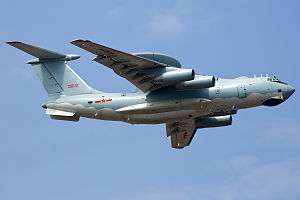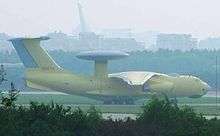KJ-2000
| KJ-2000 | |
|---|---|
 | |
| A KJ-2000 in flight at the 2014 Zhuhai Air Show | |
| Role | Airborne early warning and control |
| National origin | China |
| Designer | NRIET (radar) |
| First flight | 2003 |
| Status | Active |
| Primary user | People's Liberation Army Air Force (PLAAF) |
| Number built | 5[1] |
| Developed from | Ilyushin Il-76 (airframe) |
KJ-2000 (Chinese: 空警-2000; pinyin: Kōngjǐng Liǎngqiān; literally: "Airwarn-2000"), NATO reporting name: Mainring is a Chinese Airborne early warning and control system comprising domestically designed electronics and radars installed on a modified Ilyushin Il-76 airframe.[2]
Development

The KJ-2000 development program started after the cancellation of the A-50I deal with Israel and Russia in July 2000, due to strong U.S. pressure regarding the Israeli radar that was to be mounted. China then went on to develop a domestic AWACS and the first aircraft made its maiden flight in 2003.
Four KJ-2000 aircraft have been identified so far, but production of new aircraft will likely be delayed, dependent on the acquisition of IL-76 airframes. Currently, the Russian defense exporter Rosoboronexport has imposed a significant price hike on all future IL-76s delivered to China and India despite previous contracts. Both countries are currently in negotiation with Russia regarding this matter as of early 2008. In March 2011, Russia/China negotiations reached a new agreement to move production of IL-76s to Chinese owned companies, in this way it is expected production can be run smoothly to supply China with new IL-76 airframes, while delivery of Soloviev D-30KP-2 engines is not affected by recent issues.[3]
Due to unreliable external supplier sources, China has developed a backup known as the KJ-200 by installing a simplified system on board the Shaanxi Y-8. This aircraft has a similar configuration to that of the KJ-2000 and is characterized by the triple tail-fin configuration (one large and two small).
Design
The Chinese AWACS has a phased array radar (PAR) carried in a round radome. Unlike the US AWACS aircraft, which rotate their rotodomes to give a 360 degree coverage, the radar antenna of the Chinese AWACS does not rotate. Instead, three PAR antenna modules are placed in a triangular configuration inside the round radome to provide a 360 degree coverage. The multi-function, three-dimensional pulse-Doppler radar was developed by NII (Nanjing Electronic Technology Research Institute), and is designed to detect and track airborne and surface targets. It operates in the frequency range of 1200–1400 MHz. The antenna system consists of three phased arrays, located in a disk with a diameter of 14 meters (near the Russian by an AWACS command and control and-50 cone diameter 9 meters, similar Indian system "Falcon" – 11 meter). Each phased array has a 120-degree field of view. Maximum range of detection of air targets is 470 km. A-50I of India made by Israel adopted its design and entered service later than KJ-2000(service 2004) in 2009.[4]
KJ-3000
A new variant with a claimed fixed next generation radar was spotted in 2013.[5]
Operational history
The PLAAF's first AWACS regiment was established at a small and remote airfield in southern China, for security reasons, during late 2004. The commander appointed to the regiment was Zhang Guangjian (张广建), a pilot with over 6,000 hours of flight time on various aircraft including the Il-76. The base was re-built and re-equipped for handling the KJ-2000, the first of which reached the base in 2005. A mixed fleet of KJ-2000 and the smaller KJ-200 has been operated at the base. During 2006 a war exercise was held in north west China, during which a KJ-2000 and KJ-200 were deployed from the regiment for evaluation. Finally in 2013 a 24-hour coverage drill was held using three KJ-2000s that covered NW China, the East China Sea, and the South China Sea.[6]
Operators
- People's Liberation Army Air Force – 5 were estimated in service as of 2008.[1]
Specifications
Limited performance parameters of KJ-2000 have been published as follows:[7]
- Max speed (km/hr): 850
- Max range (km): 5500
- Max endurance (hr): 12
- Take-off weight (t): 175
- Range against fighter sized targets (km): 470
- Range against ballistic missiles (km): 1200
- Max # of target that can be tracked simultaneously: 100
See also
Related development
Related lists
References
- 1 2 "Capabilities of the Chinese People's Liberation Army to Carry Out Military Action in the Event of Regional Military Conflict" (PDF). SAIC. Archived from the original (PDF) on 2011-08-13.
- ↑ "KJ200_1". SinoDefence. Retrieved 4 February 2015.
- ↑ "IL76 russia china export agreement2011". AirForceWorld.com. Archived from the original on 3 March 2011. Retrieved 30 April 2011.
- ↑ "Kongjing-2000 (KJ-2000) Mainring". globalsecurity.org. Retrieved 22 September 2015.
- ↑ "China's AEW&C KJ-3000 air-to-surface combat aircraft – China Daily Mail". China Daily Mail. Retrieved 4 February 2015.
- ↑ John Pike. "China holds airborne early warning drill targeting Japan: report". Retrieved 4 February 2015.
- ↑ "央视曝空警-2000试验平台 公开雷内部达结构". Retrieved 4 February 2015.